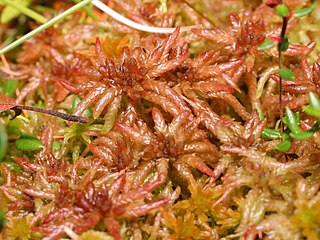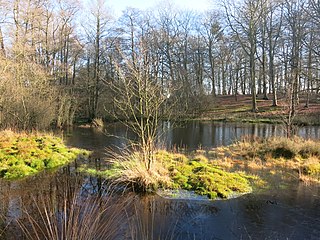
Mosses are small, non-vascular flowerless plants in the taxonomic division Bryophytasensu stricto. Bryophyta may also refer to the parent group bryophytes, which comprise liverworts, mosses, and hornworts. Mosses typically form dense green clumps or mats, often in damp or shady locations. The individual plants are usually composed of simple leaves that are generally only one cell thick, attached to a stem that may be branched or unbranched and has only a limited role in conducting water and nutrients. Although some species have conducting tissues, these are generally poorly developed and structurally different from similar tissue found in vascular plants. Mosses do not have seeds and after fertilisation develop sporophytes with unbranched stalks topped with single capsules containing spores. They are typically 0.2–10 cm (0.1–3.9 in) tall, though some species are much larger. Dawsonia, the tallest moss in the world, can grow to 50 cm (20 in) in height. There are approximately 12,000 species.

Sphagnum is a genus of approximately 380 accepted species of mosses, commonly known as sphagnum moss, also bog moss and quacker moss. Accumulations of Sphagnum can store water, since both living and dead plants can hold large quantities of water inside their cells; plants may hold 16 to 26 times as much water as their dry weight, depending on the species. The empty cells help retain water in drier conditions.
This article gives an overview of the mire plant communities in the British National Vegetation Classification system.

Norsey Wood is a 67.2-hectare (166-acre) biological Site of Special Scientific Interest in Billericay, Essex. It is also a Local Nature Reserve and a Scheduled Monument.
NVC community M1 is one of the mire communities in the British National Vegetation Classification system.
NVC community M2 is one of the mire communities in the British National Vegetation Classification system.

Cors Caron is a raised bog in Ceredigion, Wales. Cors is the Welsh word for "bog". Cors Caron covers an area of approximately 349 hectares. Cors Caron represents the most intact surviving example of a raised bog landscape in the United Kingdom. About 44 different species groups inhabit the area including various land and aquatic plants, fish, insects, crustaceans, lichen, fungi, terrestrial mammals and birds.

Gongylonema pulchrum is the only parasite of the genus Gongylonema capable of infecting humans.

Beckley Bog is a sphagnum-heath-black spruce bog located near Norfolk in Litchfield County, Connecticut. It is the southernmost sphagnum heath bog in New England. The peat moss is over 51 feet deep. It was declared a National Natural Landmark in May 1977.

Sphagnum magellanicum, commonly called Magellanic bogmoss, Magellan's sphagnum, Magellan's peatmoss or midway peat moss, is a widespread species of moss found in wet boreal forest in the far south and southwest of South America, North America and Eurasia.

Sphagnum palustre, the prairie sphagnum or blunt-leaved bogmoss, is a species of peat moss from the genus Sphagnum, in the family Sphagnaceae. Like other mosses of this type it can soak up water up to the 30-fold amount of its own dry weight thanks to its elastic spiral fibers. S. palustre is rather frequent and is spread almost all over the world. It mainly grows in wet forests and—compared to other specimens of this genus—rarely grows in moors.

Hypericum pulchrum is a flowering plant in the family Hypericaceae, commonly known as slender St John's-wort. It is native to Western Europe.

Rhododendron pulchrum (锦绣杜鹃), also identified as Rhododendron × pulchrum, is a rhododendron endemic to China. It grows as a semi-evergreen shrub, 1.5–2.5 m (4.9–8.2 ft) in height, with leathery leaf blades, elliptic-oblong to elliptic-lanceolate or oblong-oblanceolate, 2–5(–7) × 1–2.5 cm in size. The flowers are rose-purple with dark red flecks. Hirsutum describes it as "a natural hybrid; seed × pollen= R. mucronatum var mucronatum × R. indicum var formosanum".

Etheridgeum is a genus of snake in the family Colubridae. The genus is monotypic, containing the sole species Etheridgeum pulchrum, which is commonly known as the Sumatra Etheridge snake, and is native to Indonesia.

Wellington College Bog is a 6.2-hectare (15-acre) biological Site of Special Scientific Interest in the grounds of Wellington College on the northern outskirts of Sandhurst in Berkshire.

Sole Common Pond is a 3-hectare (7.4-acre) nature reserve south-west of Boxford in Berkshire in Berkshire. It is managed by the Berkshire, Buckinghamshire and Oxfordshire Wildlife Trust.













